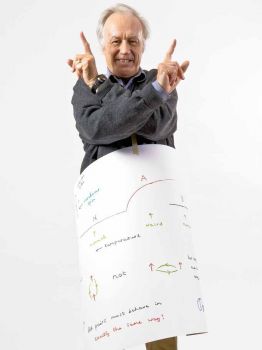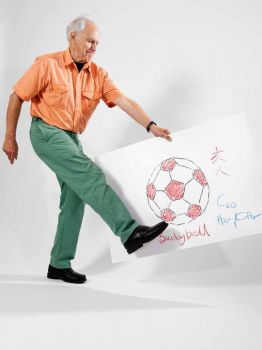Nobel prize winners draw their discoveries
Posted on behalf of: University of Sussex
Last updated: Friday, 26 July 2013

Professor Anthony Leggett wanted to show with his hands exactly how atoms form pairs to allow for superfluidity, which meant that the photographer had to tape Professor Leggett’s sketch to his body!

Professor Sir Harry Kroto drew a football and signed it with Latin and Japanese characters – then obligingly kicked it for this photograph. Professor Kroto jointly won the Nobel Prize for Chemistry in 1996.
Two Nobel Prize winners who carried out ground-breaking research during their academic careers at the University of Sussex appear in a new book of photographs.
German photographer Volker Steger handed Nobel Prize-winning scientists a large piece of white paper and some crayons and asked each of them to draw their award-winning discovery before photographing them with their sketch.
Now Professor Anthony Leggett and Professor Sir Harry Kroto are among 50 Nobel winners featured in Steger’s book, Sketches of Science, and a touring exhibition of the same title organized by the Nobel Museum.
Professor Leggett, who worked at Sussex from 1967-83, was awarded a share of the 2003 Nobel Prize for Physics, for his work at Sussex on the theory of superfluids.
In his photo (on page 87 of the book), Professor Leggett wanted to show with his hands exactly how atoms form pairs to allow for superfluidity, which meant that the photographer had to tape Professor Leggett’s sketch to his body!
Professor Kroto, meanwhile, drew a football and signed it with Latin and Japanese characters – then obligingly kicked it for the photograph (page 79).
Professor Kroto jointly won the Nobel Prize for Chemistry in 1996 for his discovery at Sussex in the 1980s of a previously unknown form of carbon, which looks like a football.
For the exhibition - which is on display at Mainau Castle in Germany until 25 August before transferring to Singapore - the Nobel Museum has paired each portrait with an audio recording of the Nobel Prize winners explaining their discoveries.

